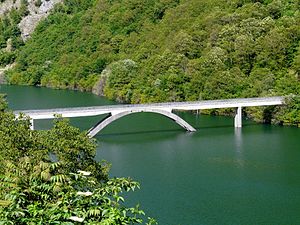Ponte Morandi (Tuscany)
Coordinates: 44 ° 6 ′ 40 ″ N , 10 ° 17 ′ 33 ″ E
| Ponte Morandi | ||
|---|---|---|
| use | footbridge | |
| Crossing of | Lake Vagli | |
| place | Vagli sotto | |
| construction | Concrete arch bridge | |
| overall length | 122 m | |
| Longest span | 70 m | |
| start of building | 1953 | |
| completion | 1955 | |
| planner | Riccardo Morandi | |
| location | ||
|
|
||
The Ponte Morandi is a pedestrian bridge near Vagli Sotto in the Italian province of Lucca in Tuscany , which crosses an arm of the dammed Lago di Vagli , in which the Lussiabach ( Fosso Lussia ) flowed. It stands in the water of the lake and is only fully visible when the water is extremely low.
description
The arch bridge was planned by Riccardo Morandi and built between 1953 and 1955 on behalf of the Società Elettrica Liguria e Toscana . Its three-hinged reinforced concrete arch has a span of 70 m. It consists of two parallel, narrow arched ribs, which are connected and stiffened by cross struts and the distance between them becomes smaller towards the top until they unite at the apex. The combatants foundations of arc ribs is a respective pair of narrow supports that, as the sheet ribs are slightly inclined towards each other. The 3.5 m wide bridge slab made of prestressed concrete is only supported by the apex and the supports.
The arch was concreted in two almost vertical halves on the transom foundations. Then one half was lowered one after the other onto a temporary tower erected in the middle of the bridge, which was removed after the arch halves had been connected. For the Storms River Bridge (Paul Sauer Bridge) built in South Africa between 1954 and 1956 , Morandi used a further development of this process: he dispensed with the temporary tower and had both halves of the bridge lowered at the same time.
photos
Web links
Individual evidence
- ↑ Official website of the Sistema Informativo Ambientale della Regione Toscana (SIRA) on Fosso Lussia , accessed on February 21, 2016 (Italian)
- ↑ Leonardo Fernández Troyano: Bridge Engineering. A global perspective. Colegio de Ingenieros de Caminos, Canales y Puentes, Thomas Telford 2003, ISBN 0-7277-3215-3 , p. 339




